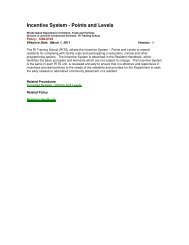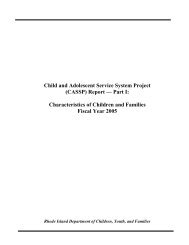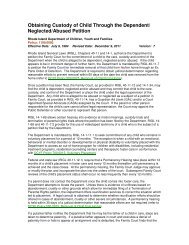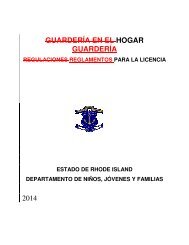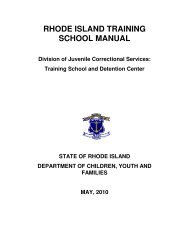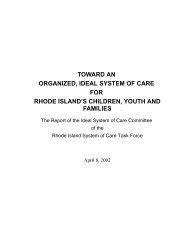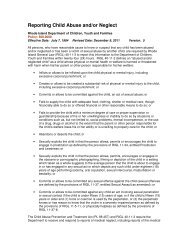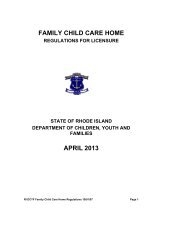Final Report - RI Department of Children, Youth & Families
Final Report - RI Department of Children, Youth & Families
Final Report - RI Department of Children, Youth & Families
You also want an ePaper? Increase the reach of your titles
YUMPU automatically turns print PDFs into web optimized ePapers that Google loves.
CHAPTER 2: COMMUNITY-STATE PREVENTION PARTNERSHIPS<br />
COMMUNITY/STATE PARTNERSHIP S RECOMMENDATIONS<br />
In this system, the Executive, Legislative, and Judicial branches <strong>of</strong> government collaborate to<br />
eliminate this fragmentation, shift responsibility for children and families to the community<br />
level, and ensure that communities are given the requisite fiscal and technical resources to be<br />
able to “take ownership” <strong>of</strong> their children and families.<br />
In order for the State to support strategic planning and local prevention service delivery, the<br />
following recommendations are made:<br />
1. $ The <strong>Children</strong>’s Cabinet must actively work with families and community leaders<br />
to strengthen existing or organize new local, collaborative strategic planning efforts<br />
aimed developing, implementing, and measuring the results <strong>of</strong> strategic plans for<br />
enhancing prevention programming and identifying the needs <strong>of</strong> the their<br />
community in relation to children and families across the system <strong>of</strong> care (see<br />
Appendix E).<br />
Significant progress has been made in the area <strong>of</strong> developing and supporting collaborative<br />
entities in the five core communities through DCYF-administered Comprehensive<br />
Strategy Initiative for Serious, Violent and Chronic Juvenile Offender. Community<br />
planning teams exist in each <strong>of</strong> the five core cities. These teams are representative <strong>of</strong> the<br />
stakeholders identified above and have successfully completed five-year strategic plans<br />
aimed at reducing juvenile violence and delinquency by supporting strong prevention and<br />
intervention programming from birth to young adulthood. Each <strong>of</strong> the Comprehensive<br />
Strategy Planning Teams are supported by the mayor <strong>of</strong> their respective city or town.<br />
With limited financial support from the state for coordination, they have used their<br />
coalitions to garner significant federal and state funds to operate youth employment<br />
programs, reading readiness programs for school-age children, mentoring programs,<br />
domestic violence awareness programs, and other services. The coordinators <strong>of</strong> these<br />
teams have played an integral role in the work <strong>of</strong> the <strong>Youth</strong> Success Cluster <strong>of</strong> the<br />
<strong>Children</strong>’s Cabinet, a state level collaboration focused on infusing a youth development<br />
philosophy within state and local initiatives and programs.<br />
Other examples <strong>of</strong> effective local partnerships have been the Local Coordinating Councils<br />
for <strong>Children</strong>’s Behavioral Health (LCC’s) and the local Substance Abuse Prevention Task<br />
Forces. Though it varies from community to community, each <strong>of</strong> these groups have been<br />
highly effective in breaking down the barriers among local agencies and finding ways to<br />
cooperatively identify resources to be used to benefit the community as a whole, rather<br />
than to build the programs and services <strong>of</strong> a particular agency.<br />
The <strong>Children</strong>’s Cabinet must focus attention on identifying with communities such<br />
partnerships and on how to build on these partnerships to enhance prevention planning<br />
and service delivery.<br />
2. $ The <strong>Children</strong>’s Cabinet must develop a permanent state staff level subcommittee<br />
to develop and coordinate prevention planning among state agencies and ensure that<br />
this subcommittee is provided the resources necessary to succeed. This<br />
subcommittee will be viewed as the state’s key link to communities and will be<br />
required to ensure community participation in their deliberations and decision-<br />
System <strong>of</strong> Care Task Force <strong>Report</strong> (January 2003) 25



